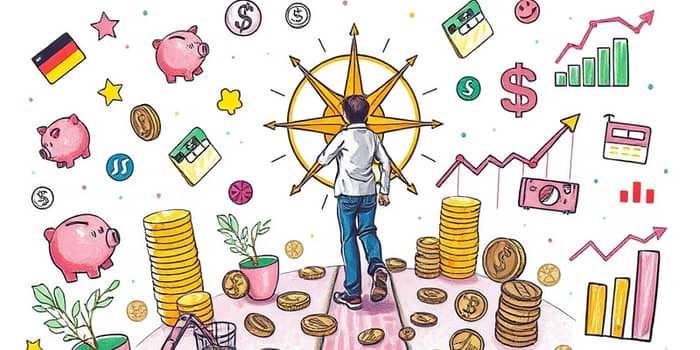As inflation reshapes the cost of everyday essentials and credit burdens weigh heavily on households, mastering the art of smart spending has never been more critical. This guide offers a comprehensive look at how you can transform your financial habits, minimize wasteful expenditures, and build a robust foundation for growth.
Understanding Today's Financial Challenges
In 2025, families across the country face unprecedented pressure on their budgets. Ongoing inflation has driven up housing, energy, and grocery costs by more than 5% year over year, straining monthly resources and forcing difficult trade-offs.
With average credit card interest rates hovering between 21% and 23% and balances approaching $8,000, many Americans feel trapped in a cycle of growing debt. The relentless accrual of interest can make even small purchases a long-term burden.
Surveys reveal that saving money remains the top priority for around 66% of adults this year, followed by boosting income (38%) and paying down balances (35%). Yet rising expenses (41%), unexpected costs (28%), and income disruptions (19%) can derail even the best-laid plans. Recognizing these headwinds is the first step toward developing resilience and adopting more adaptive financial plans.
Building Smart Spending Habits
Adopting deliberate strategies around budgeting, impulse control, and purchase timing can radically change your spending patterns. By establishing clear guardrails on daily expenses and channeling surplus into reserves, you solidify the foundation for future growth.
- Use the 50-30-20 rule for balanced spending and saving to allocate 50% of income to essentials, 30% to comforts, and 20% to savings or debt.
- Track every expense with budgeting apps or spreadsheets to uncover hidden spending leaks.
- Apply the 30-day rule to delay impulse purchases and reassess needs versus wants.
- Audit recurring subscriptions quarterly and cancel unused services to free up cash.
- Plan meals in advance and host home-based social gatherings to reduce dining and entertainment costs.
One of the most effective ways to protect your bottom line is to automatically transfer a portion of earnings into dedicated savings or investment accounts on payday. Placing funds into high-yield savings accounts or Certificates of Deposit can also provide a psychological deterrent against early withdrawals while earning competitive interest.
Replacing expensive nights out with potluck dinners or game nights at home not only strengthens relationships but also keeps your wallet healthy. Scheduling major purchases around sales events in fall and spring, and using browser extensions to track price drops, can result in significant savings.
Beyond everyday transactions, auditing recurring charges and switching providers when possible can uncover hidden savings. By implementing a psychological barrier to early withdrawal through product choices that penalize premature cash-outs, you guard your capital while staying flexible for future opportunities.
Strategic Debt Management
High-interest balances act like a slow-burning fire on your financial plan. Adopting the debt avalanche method for repayment targets the most costly interest first, reducing total interest paid over time. Alternatively, the debt snowball approach builds momentum by eliminating smaller balances quickly—choose the technique that best aligns with your psychology.
Regular check-ins and adjustments to your repayment schedule ensure consistent progress, while consulting with a certified credit counselor can provide personalized insights. Remember, each payment chips away at both principal and stress, leaving more room for investing and saving.
For homeowners and those with sizable installment loans, refinancing can be another tool for reducing monthly payments. Carefully weigh origination fees and interest rate spreads to ensure tangible long-term savings. Ultimately, combining multiple approaches creates a customized plan that accelerates debt freedom without derailing other goals.
Investing for Growth
Once high-interest obligations are under control, redirect funds to investment vehicles that can scale your wealth. Consistent contributions to retirement plans like 401(k)s and IRAs harness the power of compounding and tax advantages. Allocating a portion of your portfolio to index funds or green ETFs also allows for growth that aligns with personal values.
Exploring fractional ownership platforms opens doors to real estate projects with entry points as low as $50, while peer-to-peer lending and crowdfunding alternatives spread risk across diverse opportunities. Digital fintech solutions increasingly offer features such as automated rebalancing and tax-smart strategies, letting you focus on long-term objectives rather than daily market fluctuations.
Tax-smart strategies such as tax-loss harvesting to offset gains can optimize after-tax returns, especially in volatile markets. Additionally, maximizing employer matches in retirement plans and exploring Health Savings Accounts (HSAs) delivers dual benefits of wealth accumulation and reduced taxable income.
If environmental or social alignment matters to you, sustainable investing in green bonds or ESG (Environmental, Social, Governance) funds can satisfy both fiscal and ethical criteria. Diversifying across asset classes and geographies further shields you from localized downturns.
Platforms enabling fractional real estate investments allow you to participate in property projects with entry points as low as $50. This democratization provides access to rental or development returns that were once limited to high-net-worth individuals, all while diversifying your portfolio across asset classes.
Behavioral and Digital Tools
Turning discipline into an engaging process is key to sustainable change. Apps that round-up features on everyday purchases can effortlessly build an emergency cushion, while embracing no-spend challenges to identify hidden leaks redirects funds toward high-impact objectives. Committing to a strict no-spend period for a week or month reveals spending triggers and encourages mindful evaluation of wants versus needs.
Mobile spending freeze options let you temporarily disable cards at the tap of a button, providing another layer of control. Collaborative budgeting features, available in many apps, enable families and couples to share a financial dashboard, aligning joint goals and promoting accountability.
Leveraging notifications and calendar reminders keeps bills paid on time, avoiding late fees and credit hits. Moreover, many financial institutions now offer custom alerts for account balance thresholds and unusual transactions, empowering proactive decision-making.
Setting and Achieving Financial Goals
Articulating your ambitions through the SMART framework—Specific, Measurable, Achievable, Relevant, Time-bound—transforms abstract desires into actionable plans. For example, aim to save $6,000 for your emergency fund by December 2025 by setting aside $500 each month and tracking progress monthly.
An emergency fund covering three to six months of expenses acts as your financial shock absorber, preventing reliance on credit in times of crisis. Aim to build this reserve using automated plans and by channeling windfalls such as bonuses, tax refunds, or side gig income directly into your safety net.
Continuous financial education—from reading books to attending webinars—ensures that your knowledge evolves alongside your wealth. Periodically revisiting and adjusting your goals keeps your plan aligned with life changes, market shifts, and emerging opportunities.
Conclusion: Empowering Your Financial Future
Smart spending is not about deprivation but about intentional allocation of resources toward what truly matters. By understanding the current economic climate, embedding core principles into your daily habits, and leveraging modern tools for debt reduction and investing, you can reshape your financial narrative.
Every journey begins with a single step. Choose one tactic—whether it is setting up an automatic transfer or downloading a budgeting app—and implement it this week. Over time, these incremental changes compound into life-altering results.
Embrace smart spending not as a restriction, but as a framework for freedom and possibility. Your future self will thank you for the thoughtful choices you make today.
References
- https://www.ent.com/education-center/smart-money-management/smart-savings-resolutions-top-5-smart-money-habits-for-the-new-year/
- https://ulinwealth.com/financial-hacks-for-2025-new-years-resolutions/
- https://www.nerdwallet.com/article/finance/how-to-save-money
- https://libertygroupllc.com/blog/building-financial-habits-that-stick-long-term-wealth-strategies-for-2025/
- https://www.cbsnews.com/news/how-to-spend-less-money-in-2025/
- https://www.onedigital.com/blog/starting-the-year-strong/
- https://moneysmart.gov.au/media-centre/news-strategies-to-kickstart-a-financial-reset-in-2025
- https://privatebank.jpmorgan.com/nam/en/insights/markets-and-investing/ideas-and-insights/start-strong-our-top-10-tips-for-financial-success-in-2025










